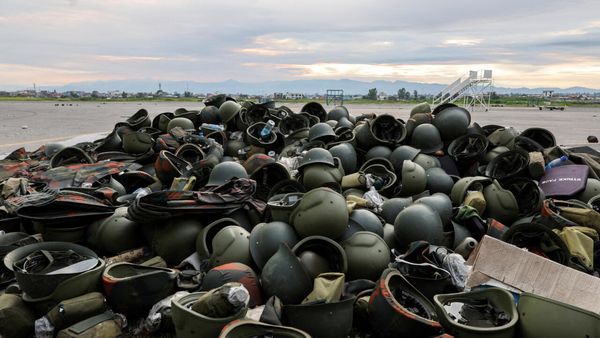Energy Australia says it has ramped up production at its Tallawarra power station on the shores of Lake Illawarra to more than double its standard capacity in response to tight gas market conditions.
Federal Energy Minister Chris Bowen is convening a meeting of state and territory energy ministers on Wednesday as gas prices soar across the country.
Resources Minister Madeleine King has been negotiating with producers to get more gas into the system.
The Tallawarra combined cycle gas power station has the potential to generate 435 megawatts of power.
In an average year, Tallawarra usually runs at around 20 per cent of its full capacity.
So far this year it is around 60 per cent, and in the past month around 75 per cent.
A spokesman for Energy Australia said it was continuing to work with suppliers and other stakeholders to ensure there was sufficient gas reserves to meet its customers' needs.
That included supporting existing gas customers and new customers transferred through the Australian Energy Regulator's (AER) Retailer of Last Resort (RoLR) arrangements.
It was also continuing with construction of hydrogen and gas capable power station Tallawarra B with over 300MW capacity at the same site.
In April, 735 cubic meters of concrete was poured for the project's gas turbine slab.
It said the Tallawarra B project would be ready for the summer of 2023-24, ahead of the scheduled retirement of the Liddell power station.
Another project it was pursuing near Lithgow in the state's central west proposes using Lake Lyell's dam, which supplies water to the Mt Piper power station, to form a new 335MW pumped hydro energy facility with eight hours of storage.
The proposal is facing opposition because of concerns about its impacts on biodiversity and tourism.
Floating gas terminal better option than new gas fields
Australian billionaire Andrew "Twiggy" Forrest's energy consortium has weighed into the national conversation around tensions in the gas market and is urging governments not to approve any new coal seam gas fields including Santos' Narrabri Gas Project.
His company, Australian Industrial Energy, has approval for a floating gas import terminal at Port Kembla.
It is currently reconstructing a wharf in the harbour and working on onshore facilities including connection to the existing Easter Gas Pipeline after signing a contract for a Floating Storage and Regasification Unit (FSRU) with a Norwegian company in November 2021.
The chairman of Australian Industrial Energy, John Hartman, said since the invasion of Ukraine, FSRU vessels were highly sought after.
"Our decision to bring the FSRU into Australia for the PKET (Port Kembla Energy Terminal) is highly dependent upon gas retailers committing to use the PKET," Mr Hartman said.
He said the company hopes to have its construction completed in late 2023.
He also argued the Port Kembla project was the nation's best pathway forward.
"The PKET is an energy security project which will enable critical energy supply.
"It will help solve the short-term supply and transportation constraints of the east coast market, but with infrastructure that can quickly be transitioned to green hydrogen and other green energy uses when the time is right.
"Investment in new gas projects just prolongs our reliance on fossil fuels."
The managing director and CEO of Santos, Kevin Gallagher, told the Melbourne Miners Club last week the current situation was not the fault of producers.
"The scarcity of new development is frightening," he said.
"Customers are crying out for this gas with more demand than we can meet when it comes to market around 2026.
He blamed 10 years of failed energy policy.
"Shortages in the domestic market and the price shocks we have seen in recent weeks have nothing to do with the behaviour of gas producers or exporters, who are doing everything they can to support the market right now," Mr Gallagher said.
"This is the consequence of more than a decade of energy policy failure that has stopped the industry developing more gas supply in a timely manner."







